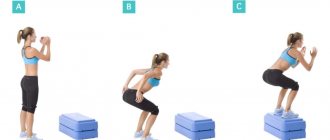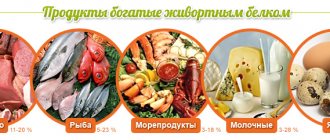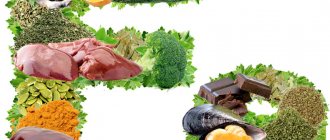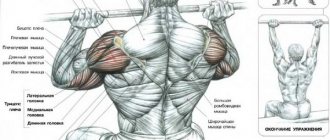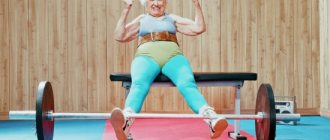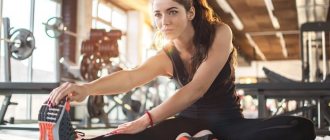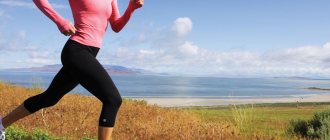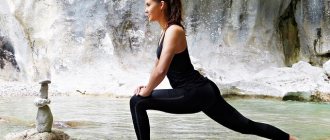Sources of injury in kettlebell lifting exercises
Many people, not just athletes, can remember the time when, accidentally approaching a kettlebell and trying to train on their own, for a long time they experienced pain in the forearm, in the back, in the knees, not to mention the lower back.
Despite the external simplicity of the exercises, such as the push of two weights from the chest, the push of two weights in a long cycle (with both weights lowered down after each rise), the jerk of one weight with each hand, they are very complex in their internal content.
The dynamics of a kettlebell lifter’s movements require a high degree of coordination in space and time of the processes of tension and relaxation of working muscles with breathing. The kinematics of movements strictly obeys the laws of Universal Gravity and Lever of the 1st, 2nd and 3rd kind. In order to lift weights about 30-40 times, you may not need to think about the complexity of the exercises. However, if we are talking about regular training, then it is necessary to think about eliminating unnecessary stress on the joints and spine, as well as about the effectiveness and efficiency of the equipment.
Many examples can be given indicating the extreme loads experienced by weightlifting athletes. So, if an athlete participating in a competition weighs 64 kg and performs a clean and jerk exercise with two 32 kg weights, then the pressure on the support already in the starting position is 200%!!! However, leading weightlifters in Russia, even in light weight categories up to 60 kg and up to 65 kg, perform 100 or more lifts of two 32 kg weights in the push exercise in 10 minutes of competition time. How??? The study of such a phenomenon and the answer to this question would lead to the elimination of the causes of injuries in kettlebell lifting and, especially, among beginner kettlebell lifters.
Currently, scientific works, articles and studies on kettlebell lifting are rarely found in print. As noted by A.I. Vorotyntsev (2002), sports science still remains in great debt to thousands of fans of kettlebell lifting. There is not enough specialized literature, and what exists does not always correspond to reality.
A.I. Vorotyntsev (2002) expresses regret that the health-improving effects of kettlebell lifting on the body of different ages have not yet been studied, therefore any experiments carried out on one’s health are not always justified: some, by doing kettlebells, become healthy and are convinced of the benefits of these classes, others, due to haste or inability to properly grasp weights, get injured and are convinced of the opposite. The problem of injury is acute in all sports, especially in youth and youth. It is young people, trying to achieve high results as quickly as possible, who do not put enough effort into studying and improving movement techniques, neglecting the principles of gradually increasing loads, optimizing the ratio of volume and intensity of load. Some young athletes overuse pharmacological agents, both to stimulate muscle activity and to quickly restore the body. This path can really lead to significant results in a short time. However, the musculoskeletal system does not always have time to prepare for increased requirements to achieve high goals in a short time.
Our studies of the characteristics of motor actions of more than three hundred weightlifters of various qualifications, carried out over several years, starting in 2002, using video recordings of all participants in the Russian Cups, Russian and World Championships and other competitions held at the regional level, allowed us to find some criteria for the effectiveness of exercise techniques kettlebell lifting and factors for increasing the efficiency of kettlebell lifters’ motor actions. Without being able to describe all of them within the framework of our article, we will present those that relate to the initial position before the next ejection. The correct starting position is one of the important prerequisites for the effective execution of subsequent movements (L.P. Matveev, 1991). Starting position, using the expression of A.A. Ukhtomsky, can be called a state of “operational rest”, in which, although there are no external movements, purposeful readiness for action is concentratedly embodied.
This or that version of the starting position before the next push-out is generally determined by the morpho-functional characteristics of the kettlebell lifter, as well as the athlete’s ability to rationally compensate for the effects of gravity of the weights, torso and head (V.N. Gomonov, 2000).
In the case of rational I.P. the spine is free from load due to the fact that the projection of the gravity forces of the weights through the elbow joints goes directly to the pelvic bones. The athlete receives a kind of rest interval (V.N. Gomonov, 2000).
Let's consider the effect of gravity of the kettlebell and the resulting gravitational force of the head and torso in the variant typical for beginner kettlebell lifters (Fig. 1) and highly qualified athletes (Fig. 2) in the starting position before the next push-out.
In Fig. 1, the line of projection of the gravity force of the weights passes down through the hip-femoral joint and, further behind the knee joint, to the support. Considering the effect of the moment of gravity of the weights relative to the joints, we see that with irrational IP, in the hip joints the effect of the moment of gravity of the weights is zero, since the shoulder of this force is zero, and in the knee joints this moment force bends the athlete's legs. The resulting gravity force of the torso and head creates a tilting moment at the hip joint and a bending moment at the knee joint. To maintain balance, the athlete is forced to constantly strain the back flexors and quadriceps muscles of the thigh. Beginners instinctively begin to bend their backs and tilt their heads forward and down, taking a position in which the lines of projection of the gravity forces of the weights and the resulting gravity of the torso and head are as close as possible, reducing the effects of the moments of these forces. The inability to relax the deltoids and trapezius muscles prevents them from placing their elbows on the iliac crests. Therefore, beginner weightlifters experience excessive bending of the back and legs at the knees. This results in excess tension in the back and knee joints.
What happens in a rational initial position before the next push-out (Fig. 2)? Ideally, the condition of balance is satisfied in the hip joint, as on a simple swing. Since the line of projection of the gravity force of the weights passes in front of the hip joint, the moment of force is equal to the product of the gravity force of the weights and the arm of this force. This moment of force tends to tilt the torso forward or straighten the arms. The projection line of the resulting force of gravity of the torso and head, passing behind the hip-femoral joint, creates a moment of force that tends to tilt the torso back. In other words, highly qualified athletes bend and tilt their torso back not because the gravitational force of the weights acts on it, but so that the shoulder of the resulting gravitational force of the torso and head becomes such that the action of the pair of forces is in equilibrium.
Balance in the knee joints is also achieved by the balance of a pair of forces: 1 – the force of gravity of the weights, the projection of which passes in front of the knee joints, is directed towards extension and 2 – the resulting force of gravity of the torso and head, the projection of which passes behind the knee joints and is directed towards side of leg flexion at these joints. When the moments of this pair of forces are equal, the tension in the quadriceps muscles of the thigh decreases, and in the case when the extension moment of the weights’ gravity force exceeds the moment of the force of bending the legs at the knee joint, they are completely relaxed.
The placement of the arms of the weights on the pads of the thumbs, the installation of the elbows on the crests of the iliac bones with straightened legs and maximally relaxed arm muscles, reduce the excessive effect of gravity forces and the moments of these forces in the joints, and also increase the efficiency of motor actions. As a rule, athletes who do not pay due attention to developing flexibility and the necessary mobility in the joints do not achieve outstanding results. Most of them remain at the CCM level. Excessive tension in the quadriceps muscles of the thigh and torso flexors, difficulty breathing due to an irrational starting position before the next push-out limit the athlete’s capabilities. There is also a theoretical justification for this. Sports science knows that maximum physical effect is achieved only under conditions of optimal levels of muscle tension (i.e. when none of the muscles produces its maximum). This is explained by the fact that their activity levels are interconnected and interdependent with each other. Therefore, an excessive increase in the level of activity of any muscle leads to a decrease in the activity of others and a decrease in the overall effect of motor actions (I.P. Ratov, 1994).
Our research allows us to draw the following conclusions:
- 1. The main source of injuries in kettlebell lifting is solving the problem of fulfilling discharge standards using force methods. In this case, the exercises are performed under conditions of excessive tension in the knee joints and lumbar spine.
- 2. Prevention of various spinal overstrains, injuries of the knee joints, sprains of tendons and muscles at all stages of preparation is carried out by rationally compensating for the effects of gravity and optimal alternation of the processes of tension and relaxation of muscle groups involved in motor actions when performing kettlebell exercises sports;
- 3. The solution to the problem of preventing injuries in kettlebell lifting lies in improving the technique of training kettlebell lifters.
Literature:
1. Gomonov, V.N. Individualization of technical and physical training of weightlifting athletes of various qualifications: Author's abstract. dis....cand. ped. Sciences (13.00.04) / V.N. Gomonov. – Smolensk: SGIFK, 2000. – 26 p. 2. Vorotyntsev, A.I. Kettlebells. Sport of the strong and healthy / A.I. Vorotyntsev. – M.: Soviet Sport, 2002. – 272 p.: ill. 3. Matveev, L.P. Theory and methodology of physical culture / L.P. Matveev. – M.: FiS, 1991. – 543 p. 4. Ratov, I.P. Motor capabilities of a person (non-traditional methods of their development and restoration) / I.P. Ratov. – Minsk: Minsktip-proekt, 1994. – 116 p.
Interview with Master of Sports of Russia Ivan Semchenko
I had the opportunity to talk with Master of Biathlon and Long Cycle Ivan Semchenko. And asked him about what exercises he uses in his training. I won’t distort his words, so I’ll convey verbatim everything he told me...
Additional exercises in the pre-competition period
In the pre-competition preparation period, all the exercises that I use in my training are only with weights (with the exception of abs, hyperextension, squats with a barbell). I train the clean and jerk together every workout.
General physical training with weights. I throw weights like I do in a long circuit; pushing out two weights (from the starting position in the jerk I push the weights out without fixing them, reset them and push them out again, without a rest interval). Walking around the gym with weights in your hands, walking around the gym with one weight above your head (holding the weight like in a snatch). I also do jumping jacks with a weight behind my back, swinging two weights in front of me (you can alternate with throwing the weights to the starting position), bench presses of one weight alternately, and rows of a heavy weight to the chin. I do walking lunges with weights to failure, then I take one weight and immediately do jumping exercises to the limit. I also do the kettlebell snatch with a glove, in a regular work glove, I just select the most slippery part of the kettlebell and snatch it!
Additional exercises after competitions
I do more of the general physical training without weights in the period after the competition. I do a lot of squats with a barbell, lunges with a barbell, deadlifts, deadlifts, rows of the upper block, rows of the lower block, bending with the barbell and bending over the horse (I do a lot of hyperextension) - this concerns the back and legs. I've always had weak hands, so I train them hard. I do the following circular set: first holding the weights (I try to hold them with my fingers), then bending my arms with a reverse grip on the barbell, then walking with weights in my hands around the gym until failure for 3-4 sets. On the shoulders I do a seated dumbbell press, a standing bench press with one dumbbell alternately, a military press and a barbell row to the chin. As well as standing dumbbell raises. For triceps I do arm extensions on a pulley with a rope, French bench press, bench press with a medium grip, arm extension with a dumbbell standing behind the head. I try to combine physical training and vary exercises so that each workout has variety. All this because it becomes psychologically tiring to do the same thing day after day. And diversity increases efficiency and impact! I have 6 workouts a week. A day in the gym, a day of running (I run with 2 kg dumbbells in my hands). At this point, Vanya finished describing his training. I will say that Ivan Semchenko is a master of sports in both biathlon and long cycle. His best results with 32 kg weights: clean and jerk - 101 lifts, total snatch - 115 lifts, clean and jerk - 61 lifts.
